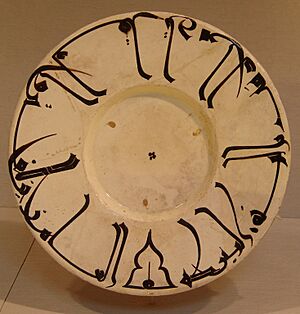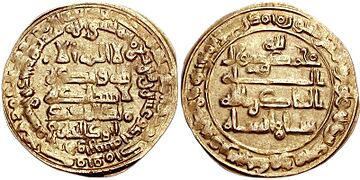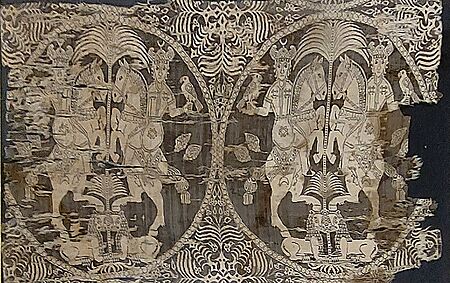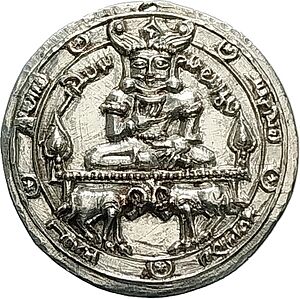Buyid dynasty facts for kids
Quick facts for kids
Buyid Dynasty
|
|||||||||||||||||||||||||||||
|---|---|---|---|---|---|---|---|---|---|---|---|---|---|---|---|---|---|---|---|---|---|---|---|---|---|---|---|---|---|
| 934–1062 | |||||||||||||||||||||||||||||

The Buyid dynasty in 970
|
|||||||||||||||||||||||||||||
| Capital | |||||||||||||||||||||||||||||
| Common languages |
|
||||||||||||||||||||||||||||
| Religion | Shia Islam (dynasty) Sunni Islam (majority) Zoroastrianism Christianity Judaism |
||||||||||||||||||||||||||||
| Government | Hereditary monarchy | ||||||||||||||||||||||||||||
| Emir/Shahanshah | |||||||||||||||||||||||||||||
|
• 934–949
|
Imad al-Dawla | ||||||||||||||||||||||||||||
|
• 1048–1062
|
Abu Mansur Fulad Sutun | ||||||||||||||||||||||||||||
| Historical era | |||||||||||||||||||||||||||||
|
• Established
|
934 | ||||||||||||||||||||||||||||
|
• Imad al-Dawla proclaimed himself "Emir"
|
934 | ||||||||||||||||||||||||||||
|
• Adud al-Dawla becomes the supreme ruler of the Buyid dynasty
|
979 | ||||||||||||||||||||||||||||
|
• Disestablished
|
1062 | ||||||||||||||||||||||||||||
| Area | |||||||||||||||||||||||||||||
| 980 est. | 1,600,000 km2 (620,000 sq mi) | ||||||||||||||||||||||||||||
| Currency | dirham, dinar | ||||||||||||||||||||||||||||
|
|||||||||||||||||||||||||||||
The Buyid dynasty (Persian: آل بویه, romanized: Âl-i Bōya), also called Buwayhid, was a powerful family from a region called Daylam in Iran. They ruled over large parts of central and southern Iran and Iraq from 934 to 1062. Their rule is sometimes called the "Iranian Intermezzo" because it was a time when many local Iranian families became strong.
The Buyid dynasty was started by Ali ibn Buya. In 934, he took control of Fars and made Shiraz his capital city. He was given the special title Imad al-Dawla, meaning "Fortifier of the State". His younger brother Hasan conquered parts of Jibal and, by 943, captured Ray, making it his capital. Hasan received the title Rukn al-Dawla, or "Pillar of the State".
In 945, the youngest brother, Ahmad ibn Buya, conquered Iraq and made Baghdad his capital. He was given the title Mu'izz al-Dawla. The Buyids were proud of their Iranian heritage. They even used an old Persian title, Shahanshah ("king of kings"), just like the ancient Sasanian emperors. They also carved messages at the famous Persepolis ruins, showing their respect for the past.
The Buyid dynasty was strongest under Panāh Khusraw, known as Adud al-Dawla. He ruled from 949 to 983. He was known for being open-minded and for building many projects, like the Band-e Amir dam near Shiraz. Under him, the Buyid lands stretched from the border of the Byzantine Empire in the west to Khorasan in the east.
Even though the Buyids were a branch of Shia Islam (first Zaydi, then Twelver), they supported the Sunni Abbasid caliphs. They were generally tolerant of the Sunni people, who were the majority in their lands. However, they did not get along with the Fatimid Caliphate in Egypt, who followed a different type of Shia Islam.
Unlike some other rulers, the Buyids governed areas with many different religions. There were Zoroastrians and Christians, especially from the Church of the East. Because of this, many records from the Buyid era were written in Middle Persian, Syriac, and Arabic.
Contents
Origins
The family name Būya comes from an old Persian name. The Buyids were descendants of a Zoroastrian man named Panah-Khusrow from Daylam. His son, Buya, was a fisherman who later became a Muslim. Buya had three sons: Ahmad, 'Ali, and Hasan. These three sons later worked together to create the Buyid kingdom. The Buyids even claimed to be related to Bahram V, an ancient Persian king from the Sasanian Empire.
History
How the Buyids Rose to Power (934–945)
'Ali ibn Buya, who founded the dynasty, started as a soldier for a warlord named Makan ibn Kaki. Later, he joined another Iranian ruler, Mardavij, who had started the Ziyarid dynasty. 'Ali's two younger brothers, Hasan and Ahmad, joined him.
In 932, 'Ali was given a region called Karaj to rule. This allowed him to gather more Daylamite soldiers for his army. However, Mardavij became worried about 'Ali's growing power and planned to kill him. Luckily, Mardavij's own chief advisor warned 'Ali.
The brothers, with 400 of their Daylamite supporters, escaped to Fars. There, they managed to take control of Arrajan. The Buyids then fought against an Abbasid general for control of Fars and won. This victory opened the way for them to conquer Shiraz, the capital of Fars.
'Ali also made friends with the landowners in Fars. He even hired Turkish soldiers for his cavalry. Mardavij later took control of Khuzestan from the Abbasids and forced 'Ali to accept him as his ruler.
Fortunately for the Buyids, Mardavij was killed in 935. This caused chaos in the Ziyarid lands, which was perfect for the Buyid brothers. Ali and Ahmad conquered Khuzistan. Hasan captured Isfahan, the Ziyarid capital, and in 943, he took Rey, making it his capital. This meant he controlled all of Jibal. In 945, Ahmad entered Iraq and made the Abbasid Caliph his puppet ruler. At this time, Ahmad was given the title Mu'izz ad-Dawla ("Fortifier of the State"). 'Ali became Imād al-Dawla ("Support of the State"), and Hasan became Rukn al-Dawla ("Pillar of the State").
Golden Age (945–983)
During this time, the Buyids expanded their lands even more. They conquered Kerman in 967, followed by Oman (967), the Jazira (979), Tabaristan (980), and Gorgan (981). After this period, the Buyid dynasty slowly started to weaken. Parts of their lands began to break away, and local rulers under them became independent.
Decline and Fall (983–1062)
The death of Adud al-Dawla marked the beginning of the Buyid dynasty's decline. His son, Abu Kalijar Marzuban, who was in Baghdad, kept his father's death a secret at first to make sure he could take over without a fight. When he finally announced his father's death, he was given the title "Samsam al-Dawla". However, Adud's other son, Shirdil Abu'l-Fawaris, challenged his power, and a civil war began.
In the mid-11th century, the Buyid lands gradually fell to other powerful groups like the Ghaznavids and Seljuk Turks. In 1029, Majd al-Dawla, who was facing a rebellion by his own soldiers in Ray, asked for help from Mahmud of Ghazna. When Sultan Mahmud arrived, he removed Majd al-Dawla from power, ending the Buyid rule in Ray.
Finally, in 1055, a Seljuk leader named Tughril conquered Baghdad. He removed the last Buyid ruler from power. Like the Buyids before them, the Seljuks kept the Abbasid caliphs as symbolic leaders, but the real power was with the Seljuks.
Government
The Buyids created a system where their lands in Iraq and western Iran were divided into three main areas. Each area had its own capital: Fars (with Shiraz), Jibal (with Ray), and Iraq (with Baghdad). Later, more smaller areas formed within the Buyid lands. Rulers passed their land down to their sons, meaning leadership was inherited.
The Buyid rulers used the title amir, which means "governor" or "prince". Usually, one of the amirs was seen as the most important and was called amir al-umara, or "senior amir". Even though the senior amir was the official head, each amir mostly controlled their own territory. Some stronger amirs also used the old Sasanian title of Shahanshah ("king of kings").
Military
At the beginning of the Buyid dynasty, their army was mostly made up of Daylamites. These were brave foot soldiers, often from farming backgrounds. Daylamites had a long history of fighting and were known for their strong shield formations. They usually carried a sword, a shield, and three spears.
As the Buyid lands grew, they started to recruit Turks for their cavalry (horseback soldiers). The Turks were important in the Abbasid army before this. The Buyid army also included Kurds. The Turks and Kurds were mostly Sunni Muslims, while the Daylamites were Shia Muslims. The Daylamites and Turks often argued about who was more important in the army.
To pay their soldiers, the Buyid amirs often gave them iqtāʾs. This meant the soldiers received a percentage of the tax money from a certain area. Sometimes, they were also paid with goods instead of money. In Buyid Iraq, the Turks were favored, but in Buyid Iran, the Daylamites were preferred.
Culture
Language
Unlike some other dynasties, the Buyids did not make New Persian their official language. Instead, Arabic was the main language used for communication and in the courts. Middle Persian was sometimes used as a second language in the court. Even though the Buyids were from Iran, they supported writing in Arabic and used it for letters and poetry.

It's not clear why the Buyids didn't promote New Persian more. Some historians think it might be because they were influenced by Baghdad, where Arabic writing was very important. Also, Zoroastrian priests in places like Fars still wrote in Middle Persian. New Persian might also have been very different from the local languages in western Iran.
However, New Persian was still used for poetry in the Buyid courts. Many famous poets wrote in New Persian during this time. Even the Persian chief advisor, Sahib ibn Abbad, who preferred Arabic, accepted New Persian poems written in his honor. The Buyids also encouraged fahlaviyat, which was poetry written in local western Iranian languages. Because there were many Zoroastrians and Christians, many records were also written in Middle Persian, Syriac, and Arabic.
Naming and Celebrations
While the first Buyid brothers had Arabic names, their children often had Iranian names like Kamrava, Marzuban, Bahram, and Khusraw. The Buyids carved many messages at the ancient Persepolis ruins, showing their respect for the site. They believed it was built by the legendary Iranian king Jamshid.
Adud al-Dawla celebrated old Iranian festivals like Sadeh and Mehregan. He also likely celebrated Nowruz, which many Islamic rulers did. He even created two new festivals based on Nowruz, celebrated every year in a town he built called Fana Khusraw-gird.
During the Buyid rule, the idea of "Iranshahr" (Iran) appeared in geography books, mostly written in Arabic by Iranian authors. A geographer from the late 10th century wrote that "the best cultivated, fairest and most fertile part of the world... is the kingdom of Iranshahr." This shows that people under the Buyids felt a strong sense of Iranian identity.
Religion
Like most Daylamites at the time, the Buyids were Shia Muslims. They are often called Twelvers. However, they likely started as Zaydis. One reason they might have changed to Twelverism is that, as they were not direct descendants of Ali (the first Shia Imam), Zaydism would have required them to appoint an Imam from Ali's family. Twelverism, with its hidden Imam, was a more politically useful choice for them.
The Buyids rarely forced their religious views on their people unless it helped them politically. The Sunni Abbasid caliphs remained as religious leaders, but they had no real power. To avoid problems between Shia and Sunni Muslims, the Buyid amirs sometimes appointed Christians to important government jobs instead of Muslims from either group.
Architecture
Under the Buyids, many large building and engineering projects took place. They built irrigation systems and improved farming, which helped increase their income. The Buyids loved construction projects. When Mu'izz al-Dawla arrived in Iraq, the country was damaged from local fights. He ordered the Baduriya dam on the Rufayl river to be fixed. This led to lower prices for food like bread and encouraged people to move to Baghdad.
Most of the Buyid building and restoration projects happened during the rule of Adud al-Dawla. Under him, Shiraz became so crowded that he had a special new area built called Fana Khusraw-gird. This name was chosen to sound like towns built by the old Sasanian kings. Adud al-Dawla also improved the town of Firuzabad, which was linked to the Sasanian king Ardashir I. This was probably done to show his connection to Sasanian royalty. One of Adud al-Dawla's most lasting projects was the mausoleum he built over the burial place of Ali.
Buyid rulers

Main Rulers
Usually, the three most powerful Buyid amirs at any time were those controlling Fars, Jibal, and Iraq. Sometimes, one ruler would control more than one region, but no single Buyid ruler ever directly controlled all three.
Buyids in Fars
- Imad al-Dawla (934–949)
- 'Adud al-Dawla (949–983)
- Sharaf al-Dawla (983–989)
- Samsam al-Dawla (989–998)
- Baha' al-Dawla (998–1012)
- Sultan al-Dawla (1012–1024)
- Abu Kalijar (1024–1048)
- Abu Mansur Fulad Sutun (1048–1051)
- Abu Sa'd Khusrau Shah (1051–1054)
- Abu Mansur Fulad Sutun (1051–1062)
Buyids in Ray
- Rukn al-Dawla (935–976)
- Fakhr al-Dawla (976–980)
- Mu'ayyad al-Dawla (980–983)
- Fakhr al-Dawla (restored) (984–997)
- Majd al-Dawla (997–1029)
Buyids in Iraq
- Mu'izz al-Dawla (945–967)
- 'Izz al-Dawla (966–978)
- 'Adud al-Dawla (978–983)
- Samsam al-Dawla (983–987)
- Sharaf al-Dawla (987–989)
- Baha' al-Dawla (989–1012)
- Sultan al-Dawla (1012–1021)
- Musharrif al-Dawla (1021–1025)
- Jalal al-Dawla (1025–1044)
- Abu Kalijar (1044–1048)
- Al-Malik al-Rahim (1048–1055)
Minor Rulers
Sometimes, younger sons would start their own ruling families, or individual Buyid members would take control of a province. This list is not complete.
Buyids in Basra
- Diya' al-Dawla (980s)
Buyids in Hamadan
- Mu'ayyad al-Dawla (976–983)
- Shams al-Dawla (997–1021)
- Sama' al-Dawla (1021–1024)
Buyids in Kerman
- Qawam al-Dawla (1012–1028)
Buyids of Khuzistan
- Taj al-Dawla (980s)
Family tree
| Buya | |||||||||||||||||||||||||||||||||||||||||||||||||||||||||||||||||||||||||||||||||||||||
| Imad al-Dawla 934–949 |
Rukn al-Dawla 935–976 |
Mu'izz al-Dawla 945–967 |
Kama | ||||||||||||||||||||||||||||||||||||||||||||||||||||||||||||||||||||||||||||||||||||
| Abu Ishaq Ibrahim | Izz al-Dawla 967–978 |
Sanad al-Dawla | Marzuban | Zubayda | Abu Tahir | Ali ibn Kama | |||||||||||||||||||||||||||||||||||||||||||||||||||||||||||||||||||||||||||||||||
| Marzuban ibn Bakhtiyar | Salar | Unnamed princess | |||||||||||||||||||||||||||||||||||||||||||||||||||||||||||||||||||||||||||||||||||||
| Fakhr al-Dawla 976–997 |
'Adud al-Dawla 949–983 |
Mu'ayyad al-Dawla 980–983 |
|||||||||||||||||||||||||||||||||||||||||||||||||||||||||||||||||||||||||||||||||||||
| Shams al-Dawla 997–1021 |
Majd al-Dawla 997–1029 |
Sharaf al-Dawla 983–989 |
Samsam al-Dawla 983–998 |
Baha' al-Dawla 998–1012 |
Shahnaz | ||||||||||||||||||||||||||||||||||||||||||||||||||||||||||||||||||||||||||||||||||
| Sama' al-Dawla 1021–1024 |
Qawam al-Dawla 1012–1028 |
Sultan al-Dawla 1012–1024 |
Musharrif al-Dawla 1021–1025 |
Jalal al-Dawla 1027–1044 |
|||||||||||||||||||||||||||||||||||||||||||||||||||||||||||||||||||||||||||||||||||
| Fana-Khusrau | Abu Dulaf | ||||||||||||||||||||||||||||||||||||||||||||||||||||||||||||||||||||||||||||||||||||||
| Abu Kalijar 1024–1048 |
Al-Malik al-Aziz | Abu Mansur Ali | |||||||||||||||||||||||||||||||||||||||||||||||||||||||||||||||||||||||||||||||||||||
| Abu Ali Fana-Khusrau | Abu Mansur Fulad Sutun 1048–1062 |
Al-Malik al-Rahim 1048–1055 |
Kamrava | Abu'l-Muzaffar Bahram | Abu Sa'd Khusrau Shah | ||||||||||||||||||||||||||||||||||||||||||||||||||||||||||||||||||||||||||||||||||
| Abu'l-Ghana'im al-Marzuban | Surkhab | ||||||||||||||||||||||||||||||||||||||||||||||||||||||||||||||||||||||||||||||||||||||
See also
- Iranian Intermezzo
- List of kings of Persia
- List of Shi'a Muslims dynasties
Sources
- Blair, Sheila S. (2009). "Būyid art and architecture". Encyclopaedia of Islam, THREE. Brill Online.
- Bosworth, C. E. (1968). "The Political and Dynastic History of the Iranian World (A.D. 1000–1217)". [Buyid dynasty at Google Books The Cambridge History of Iran, Volume 5: The Saljuq and Mongol Periods]. Cambridge: Cambridge University Press. pp. 1–203. ISBN 0-521-06936-X. https://books.google.com/books?id=16yHq5v3QZAC&pg=PA1.
- Busse, Heribert (1975). "Iran Under the Buyids". [Buyid dynasty at Google Books The Cambridge History of Iran, Volume 4: From the Arab Invasion to the Saljuqs]. Cambridge: Cambridge University Press. pp. 250–305. ISBN 0-521-20093-8. https://books.google.com/books?id=hvx9jq_2L3EC&pg=PA250.
- "Buwayhids or Būyids". The Encyclopaedia of Islam, New Edition, Volume I: A–B. (1960). Leiden: E. J. Brill. 1350–1357.
- Donohue, John J. (2003). [Buyid dynasty at Google Books The Buwayhid Dynasty in Iraq 334 H./945 to 403 H./1012: Shaping Institutions for the Future]. Leiden and Boston: Brill. ISBN 90-04-12860-3. Buyid dynasty at Google Books.
- Edward Granville Browne, Islamic Medicine, 2002, ISBN: 81-87570-19-9
- Kennedy, Hugh (2004). [Buyid dynasty at Google Books The Prophet and the Age of the Caliphates: The Islamic Near East from the 6th to the 11th Century] (Second ed.). Harlow: Longman. ISBN 978-0-582-40525-7. Buyid dynasty at Google Books.
- Madelung, Wilfred (1975). "The Minor Dynasties of Northern Iran". [Buyid dynasty at Google Books The Cambridge History of Iran, Volume 4: From the Arab Invasion to the Saljuqs]. Cambridge: Cambridge University Press. pp. 198–249. ISBN 0-521-20093-8. https://books.google.com/books?id=hvx9jq_2L3EC&pg=PA198.
- "[1]". Encyclopaedia Islamica Online. Brill Online.





